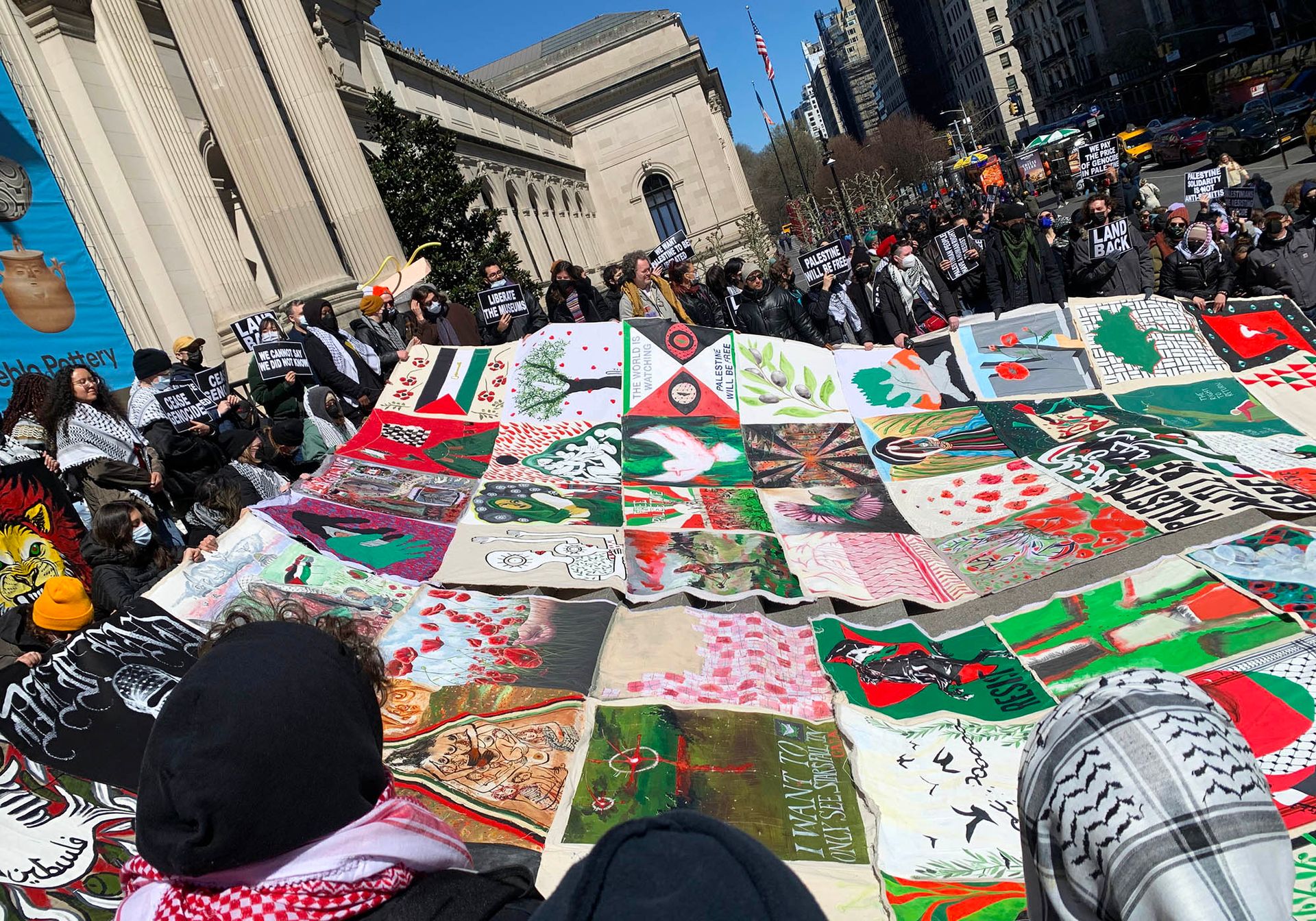Hundreds of artists, cultural workers and activists gathered on the steps of the Metropolitan Museum of Art on New York’s Fifth Avenue on Sunday (March 24) to publicly call for the most visited museum in the US to call for a ceasefire in the war in Gaza. and undertake to preserve the cultural heritage of Palestine. Demonstrators unfurled a 30-by-50-meter quilt with designs sewn, painted and printed by more than 60 artists expressing solidarity with the Palestinians.
The quilt was organized by an international group of artists inspired by the Names Project Aids Memorial Quilt., started in 1987 as a memorial to US HIV and AIDS victims and continues today. The panels of the pro-Palestine quilt, most often featuring the red, green and black of the country’s flag, vary widely in style and tone, starting with references to Pablo Picasso. Guernsey (1937) and Jenin Horse Iconography such as West Bank sculpture, poppies, doves, pomegranates, watermelons, etc. Some show scenes of violence and trauma, with parents protecting their children.

On March 24th, protesters at the Metropolitan Museum of Art took a pro-Palestine quilt created by the Hope in the Art World group. Benjamin Sutton
“The images that stick in my mind are parents holding children, siblings holding each other, protecting loved ones and asking for help,” says Brooklyn artist Sara Erenthal, who helped make the quilt. Its square features two stylized figures crying and raising their hands in need. “As a Jew, it is important to lend my voice to this cause.”
Another Brooklyn-based artist who helped organize the quilt project said it was inspired by the participants’ experiences of censorship in the art world, where expressions of solidarity with Palestine or criticism of the Israeli government are often construed as anti-Semitism.
“Many artists in the group were losing sales, losing opportunities, canceling shows every time they made public statements calling for a ceasefire,” says the organizer. “We cannot lose our ability to be vocal and take a stand for Palestine.” The group is selling prints based on quilt squares, all proceeds going to the United Nations Relief and Works Agency (UNRWA).

Members of Incite NYC lead a performance song and dance at the March 24 pro-Palestine protest at the Metropolitan Museum of Art in New York. Benjamin Sutton
In addition to the quilt, protesters held up signs with messages such as “stop genocide” and “free the museums,” chanting slogans including “Met Museum, you’re complicit, children are dying every minute” and “not another nickel, not another dime.” they had , no more money for crimes in Israel”. Participants recited poetry, sang, played instruments and danced as dozens of New York Police Department officers and Met security personnel kept watch. A speaker applauded more than 150 museum staff who signed an open letter calling on its director and CEO Max Hollein to “take a stand in defense of Palestinians and the cultural heritage of Palestine”. A spokesman for the museum declined to comment on the protest.
While many museum visitors and passers-by appeared supportive, a few made obscene gestures at the crowd or shouted competing messages. “Free the hostages,” a man shouted on October 7, referring to the 100 or so Israeli hostages still held by Hamas in Gaza; the crowd answered: “Yes, free everyone!”

The leaflets produced for the March 24 protest, in the style of the Met’s official materials, urge readers to “throw away the fine art of Imperialism”. Benjamin Sutton
Pamphlets handed out by activists outside the museum and inside its Great Hall outlined the aims of the protest and called on the organization to sever ties with three longtime friends, whom they see as complicit in the current crisis in Gaza. These include cosmetics magnate, Neue Galerie founder and World Jewish Congress President Ronald Lauder (“he has been key in promoting the conflation of anti-Zionism and anti-Semitism,” according to the pamphlet), Morgan Stanley CEO Edward Pick (his company has more than $3 billion (at the arms and aerospace company Raytheon Technologies, which has benefited from US military aid to Israel) and Michael Steinhardt—a collector who has turned over more than 100 stolen antiquities, more than 20 of which are said to have come from the West Bank. to the pamphlet
According to the local Ministry of Health more than 32,000 Palestinians have been killed since Israel began its invasion of the Gaza Strip, following the Hamas attack on Israel on October 7, in which around 1,200 people were killed and more than 200 were taken hostage. (A few hours after the protest, a temporary ceasefire agreement and a deal to exchange Israeli hostages for Palestinian prisoners became a real possibility for the first time in months.)


